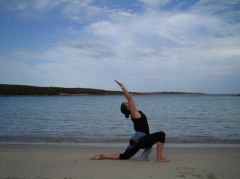Yoga to balance Pitta dosha
July 24, 2013
 Yoga is good for everybody, but needs to be tailored for each and every one of us. This article looks at how Pitta types can tailor their practice. However, as the focus in Summer is on reducing excess heat in the body, these tips can be helpful for all in heat.
Yoga is good for everybody, but needs to be tailored for each and every one of us. This article looks at how Pitta types can tailor their practice. However, as the focus in Summer is on reducing excess heat in the body, these tips can be helpful for all in heat.
Pitta types tend to have the best focus and determination of the three types, with a disciplined practice once oriented correctly. However, they tend to overheat and be irritable, and may even lack the patience to get started. They may overdue postures, even becoming aggressive with themselves. Finally, they can stick to poses they can do well ignoring the ones that they are most in need of to develop further.
So key words for Pitta balancing yoga are: cooling, relaxing, surrendering, forgiving, gentle.

David Frawley writes: “Pittas should perform asanas in a way that is cooling, nurturing, expansive and relaxing. This requires relaxing breaths and quiet sitting between strong asanas to release any stress that is developing… This does not mean that they cannot do any strong practice but that they should make sure to compensate for any heat created by ending with cooling postures and cooling pranayama.” (Frawley, Yoga and Ayurveda)
Those people with an imbalance in the Pitta dosha tend to suffer from excess heat in their bodies. Calming and cooling poses which compress the solar plexus (where Pitta resides) help balance them, while poses which extend the solar plexus help dissipate heat in the body. However, Mukunda Stiles (who has also written a great book on tailoring your yoga practice with Ayurveda) warns not to fall for the temptation to over-cool Pitta- our bellies should be warm, but our heads cool. Pitta types tend to be good at asanas but can’t do some of the poses Vata types find easy due to their shorter bones. Their practice should cool the head and blood, calm the heart and relieve tension.
Some important points to remember:
- Keeping energy cool, open and receptive- surrender to the postures rather than commanding them.
- Have fun and not taking themselves or the pose too seriously.
- Soften gaze downward, at the horizon or even practice with eyes closed.
- Allow freedom and creativity in your practice and avoid sticking to one style or series of poses.
- Avoid practicing in extremely heated spaces and make sure there is plenty of practice space
- Enjoy the experience of yoga in the body and not the brain.
- Work at 80% effort and remember yoga is not a competition. Less is more!
- Avoid being judgmental and critical of yourself.
- Focus on your exhalation, exhaling through the mouth to relieve heat as needed. Also use the exhalation to let go and release any built up anger, frustration, stress, etc.
- Practice plenty of twists and side body openers.
- Benefit from practicing at a moderate pace.
Good postures for balancing Pitta dosha:
- Sitting postures in general (but not Lion pose)
- Moon salutation (or modified sun salute with less repetitions)
- Standing poses especially which open the hips like Tree pose, Trikonasana, Ardha Chandrasana (Half moon) and standing forward bend with legs apart
- Seated forward bends which compress the abdomen eg: Janu Sirsasana
- Shoulderstand, Plough and Fish are all cooling but avoid prolonged headstand which is heating, especially for the head and eyes (Pitta site). Avoid completely with any eye disease.
- Backbends in moderation: Bhujangasana (Cobra), Dhanurasana (Bow), Ustrasana (Camel) dissipate excess heat and open up the abdomen, solar plexus and chest allowing for freer movement of energy through these regions. These asanas can play a role in the treatment of ulcers and hepatitis. Must be balanced with forward bends.
- Other poses: Boat pose, foetal pose
- Twists eg: seated spinal twist to clear the liver and detoxify Pitta
- Savasana and Yoga mudra (yogic seal)

“From asana arises steadiness of body and mind, freedom from disease and lightness of the limbs.” (Hatha Yoga Pradipika 1.17)
